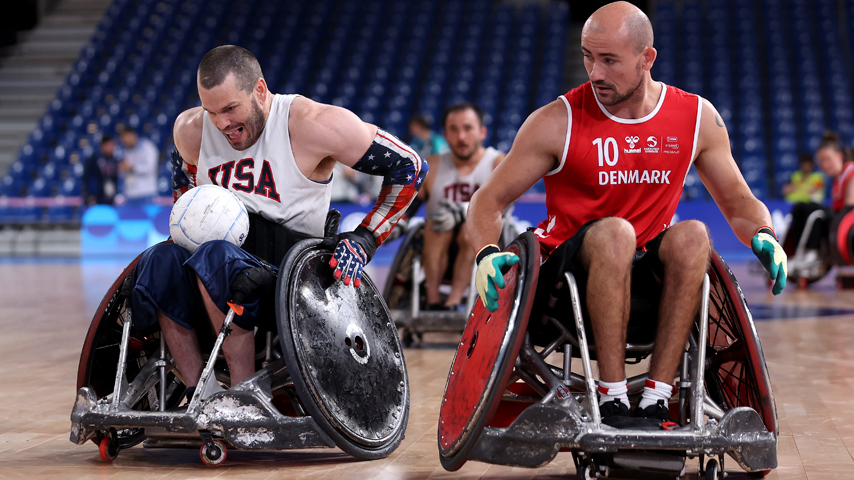Equipment Makes 5 Paralympic Sports Possible
Equipment Makes 5 Paralympic Sports Possible


Most athletes use equipment of some kind to perform their sport—the tools that para-athletes rely on range from the homemade to the 3D-printed.
Once every four years, disabled athletes from around the world gather to compete at the Paralympic Games. The Paris 2024 games, which kicked off Aug. 28, will feature 22 sports across 12 days of competition. According to the International Paralympic Committee, about 4,400 paralympians from around the world will compete in 549 medal events.
To ensure fairness and everyone’s ability to participate, para-athletes use a range of accessories, equipment, and other technologies when competing—all realized through some smart engineering. Here are five Paralympic sports that will be contested in Paris and some of the devices that help these athletes achieve new heights.
Para archery
As one of the sports that most closely resembles its able-bodied counterpart, archery offers a space for para-athletes of all kinds. Although the bows themselves are largely the same, there are a wide range of accessories that make Paralympic competition possible and most of them tailored to meet the specialized needs of each athlete.
Stools, for example, help stabilize an archer to ensure the best possible aim and can be made from materials such as carbon fiber and aerospace-grade aluminum. Custom grips—often 3D printed—allow a para-athlete to hold on to a bow no matter their disability.
Discover the Benefits of ASME Membership
Release braces, which help individuals fire an arrow, are often built by the athletes and their teams to suit specific needs, although there are standard versions as well. Depending on the user, release braces are routinely seen mounted on the athlete’s back or shoulder, with a mechanism that triggers the release by mouth or shoulder. All customized equipment must meet official regulations to be used in Paralympic competition.
Wheelchair rugby
There are multiple wheelchair sports, from basketball to fencing and tennis, but one of the newer ones is rugby.
Invented in 1977, wheelchair rugby first joined the Paralympic roster at the 1996 Atlanta games as a demonstration sport, then became a full medal sport at the 2000 Sydney games. Although those new to the sport can use any type of manual wheelchair to play the game, there are actually two different types of wheelchairs used at competitive levels—most made from aluminum or titanium and may feature up to five or six wheels.
First are offensive chairs, which have a front bumper and wings on the sides to keep them from getting caught up on other chairs. Typically, athletes with more function will use offensive chairs, which are designed to be faster and more agile. The other type is defensive wheelchairs, which feature bumpers or hooks on the front that are designed to block or hold on to other wheelchairs.
Para swimming
Dating back to the inaugural 1960 Paralympic Games in Rome, para swimming allows swimmers with physical and mental disabilities to compete. Although prostheses aren’t allowed in competition, other innovations are making their way into the pool.
When para swimmers are coming up to the wall, tapper devices allow an official or coach to notify the athlete of the impending obstacle. But there isn’t an official version of this device—they're often homemade, featuring a pole with a foam end to tap the swimmer from above to let them know when it’s time to turn.
Editor's Choice: 8 Engineers Competing in the Paris 2024 Olympics
A more recent invention is a digital swim cap developed by Samsung, which alerts visually impaired swimmers when they’re about to reach the wall. The cap features a vibrating sensor and relies on bluetooth, through which a coach can send a signal using a smart device, causing the cap to vibrate.
Para-cycling
On the road and track, Paralympic cyclists compete in a wide range of events—Paris 2024 will feature 17 track events and 34 road events.
Athletes can compete in the road events on bicycles, handcycles, tricycles, and tandems, while track races feature bicycles and tandems—visually impaired athletes will ride tandem with a pilot in front. There are also sport classes that ensure athletes are competing against other athletes with similar impairments.
Racing bikes used by para cyclists are often standard racing bikes—albeit with some special modifications. Specialized handlebars can accommodate upper body disabilities, while athletes with lower body disabilities can attach prostheses directly to bike pedals.
More for You: Gold Medal Engineering at the Olympics
Handcycles and tricycles are also built in a similar fashion to racing bikes, featuring carbon frames and multiple gears. Designing and building these bikes has become increasingly complex, and many athletes are turning to 3D printing to ensure modifications are as personalized as possible.
Para track and field
Perhaps the most iconic Paralympic athletes are those who run, jump, and more with the help of lower-limb prosthetics, often called running blades.
Manufacturers such as Össur and Ottobock are creating such carbon fiber prostheses that fully consider the athlete’s sport, their height and weight, as well as residual limb strength and alignment. It’s another application where 3D printing is being widely used as well.
These blades work by translating the energy an athlete produces when running from potential to kinetic energy—the blades’ compression stores potential energy, which is then released as kinetic energy when the blade extends, propelling the athlete forward.
Louise Poirier is senior editor.










